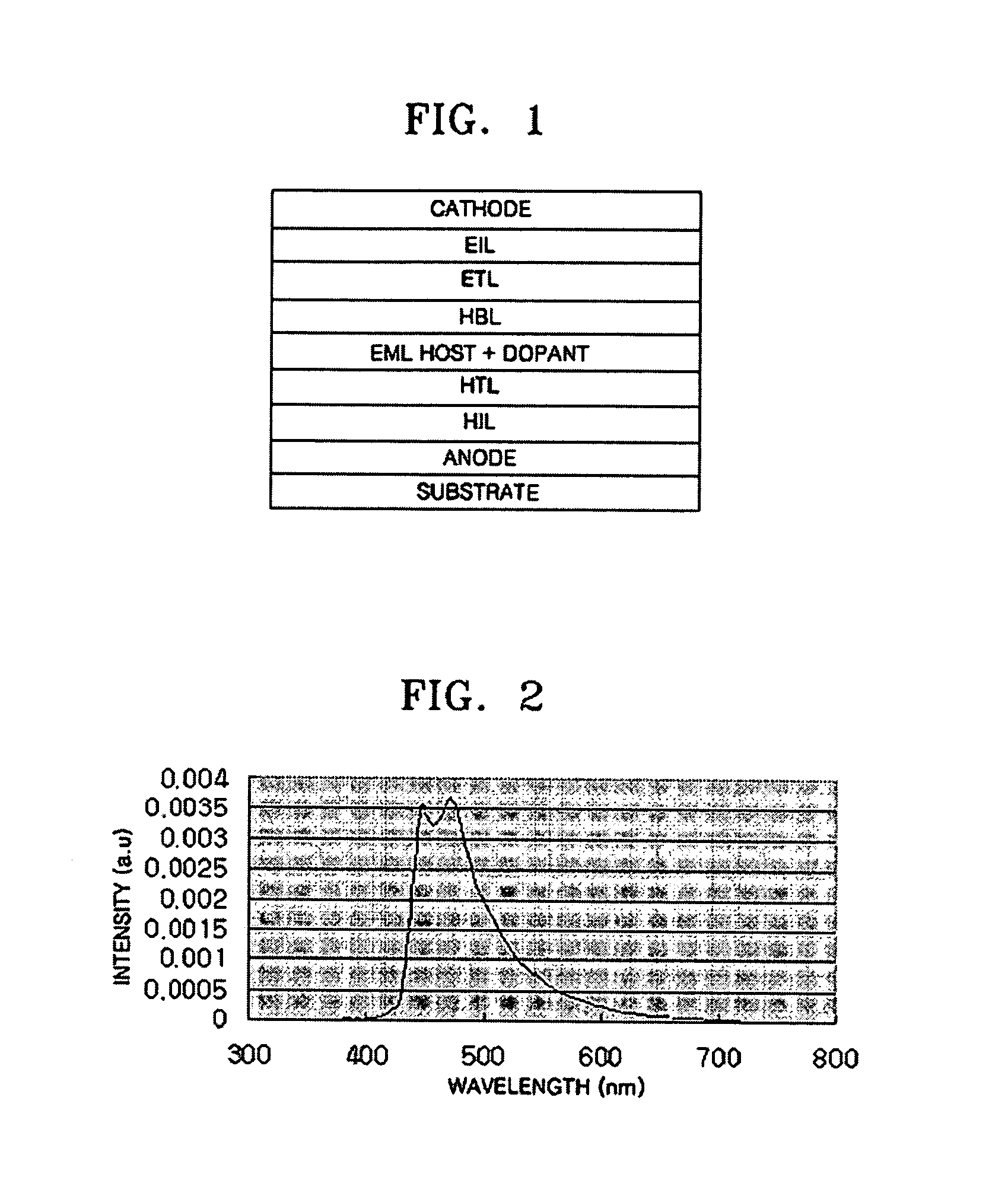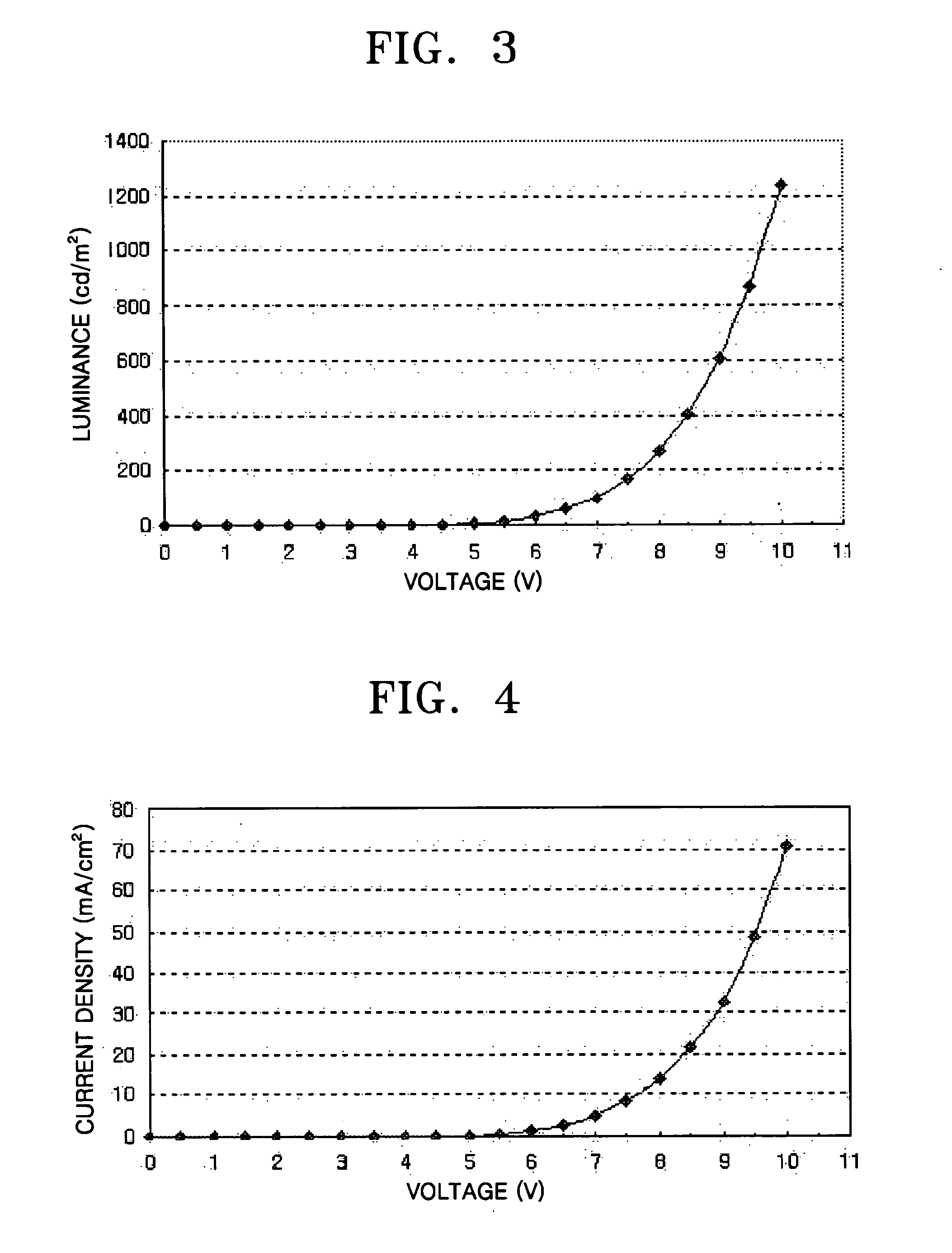Ir compound and organic electroluminescent device using the same
- Summary
- Abstract
- Description
- Claims
- Application Information
AI Technical Summary
Benefits of technology
Problems solved by technology
Method used
Image
Examples
synthesis example 1
Synthesis of Intermediates of (B-1) and (E-1)
[0038]
1) Synthesis of Intermediate (D-1)
[0039] 6.0 ml (12.0 mmol) of lithium diisopropylamide (LDA) were added to 50 ml of diethylether. 0.91 ml (10.0 mmol) of difluoropyridine were added dropwise at −78□, and stirred for one hour. 1.4 ml (12.5 mmol) of trimethylborate were added to the resultant mixture, and stirred at room temperature for one hour.
[0040] After the reaction was completed, 20 ml of 5% NaOH aqueous solution were added to the reaction mixture. The reaction mixture was separated into an organic layer and an aqueous solution layer. The aqueous solution layer was neutralized using a 3N HCl aqueous solution. The neutralized aqueous solution layer was extracted using 20 ml of ethylacetate. This extracting process was repeated thrice to obtain an organic layer. The organic layer was dried over MgSO4. The resultant remains were dried again in a vacuum state to attain white solid of an intermediate (B-1). The amount of B-1 was 1...
synthesis example 2
Synthesis of First Compound (19)
[0044]
[0045] 300 mg (0.47 mmol) of the intermediate (E-1), 174 mg (1.41 mmol) of picolinic acid, 0.24 ml (0.71 mmol) of a 3N NaOH aqueous solution were dissolved in 2-ethoxyethanol, and then stirred at 120° C. for 5 hours. After the reaction was completed, the 2-ethoxyethanol was removed from the reaction mixture. The result was diluted using dichloro methane, and then washed with distilled water. The result was separated into an organic layer and an aqueous solution layer. The organic layer was dried over MgSO4 and the solvent was removed. The resultant was purified using recrystallization to attain a first compound (19). The amount of the first compound (19) was 230 mg (yield: 68%). The first compound (19) was identified using 1H-NMR.
[0046]1H NMR (CDCl3, 400 MHz)δ(ppm) 8.58 (d, J=6.04 Hz, 1H), 8.36(d, J=7.72 Hz, 1H), 8.14 (s, 1H), 8.08 (s,1H), 8.01 (dd, J=7.68,7.72 Hz, 1H), 7.77 (d, J=5.52 Hz, 1H), 7.49 (dd, J=6.80,6.20 Hz, 1H), 7.25 (s, 1H), 7.12...
synthesis example 3
Synthesis of Second Compound (33)
[0047]
[0048] 700 mg (0.911 mmol) of the intermediate (E-1), 383 mg (2.73 mmol) of 1,5-dimethyl-1H-pyrazole-3-carboxylic acid (dm3pc), 0.46 ml (1.37 mmol) of a 3N NaOH aqueous solution were dissolved in 2-ethoxyethanol, and then stirred at 120° C. for 5 hours. After the reaction was completed, the 2-ethoxyethanol was removed from the reaction mixture. The result was diluted using dichloro methane, and then washed with distilled water. The result was separated into an organic layer and an aqueous solution layer. The organic layer was dried using MgSO4 to remove a solvent. The resultant remains were refined using recrystallization to attain a second compound (33). The amount of the second compound (33) was 620 mg (yield: 92%). The second compound (33) was identified using 1H-NMR.
[0049]1H NMR (CDC13, 400 MHz)δ(ppm) 8.63 (d, J=5.84 Hz, 1H), 8.11 (s, 2H), 7.41 (d, J=5.88 Hz, 1H), 7.17 (d, J=5.52 Hz, 1H), 6.98 (d, J=5.12 Hz, 1H), 6.60 (s, 1H), 5.86 (s, 1H...
PUM
| Property | Measurement | Unit |
|---|---|---|
| Percent by mass | aaaaa | aaaaa |
| Percent by mass | aaaaa | aaaaa |
| Electrical inductance | aaaaa | aaaaa |
Abstract
Description
Claims
Application Information
 Login to View More
Login to View More - R&D
- Intellectual Property
- Life Sciences
- Materials
- Tech Scout
- Unparalleled Data Quality
- Higher Quality Content
- 60% Fewer Hallucinations
Browse by: Latest US Patents, China's latest patents, Technical Efficacy Thesaurus, Application Domain, Technology Topic, Popular Technical Reports.
© 2025 PatSnap. All rights reserved.Legal|Privacy policy|Modern Slavery Act Transparency Statement|Sitemap|About US| Contact US: help@patsnap.com



